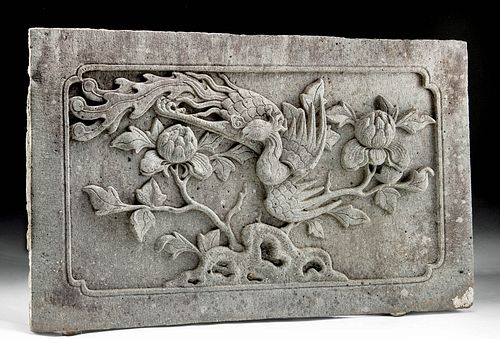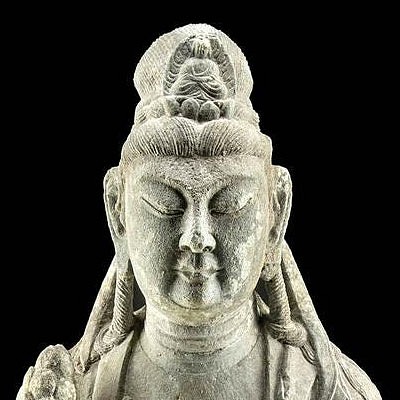Massive Chinese Ming Dynasty Stone Panel w/ Phoenix
Lot 24b
About Seller
Artemis Gallery
686 S Taylor Ave, Ste 106
Louisville, CO 80027
United States
Selling antiquities, ancient and ethnographic art online since 1993, Artemis Gallery specializes in Classical Antiquities (Egyptian, Greek, Roman, Near Eastern), Asian, Pre-Columbian, African / Tribal / Oceanographic art. Our extensive inventory includes pottery, stone, metal, wood, glass and textil...Read more
Categories
Estimate:
$4,000 - $6,000
Absentee vs Live bid
Two ways to bid:
- Leave a max absentee bid and the platform will bid on your behalf up to your maximum bid during the live auction.
- Bid live during the auction and your bids will be submitted real-time to the auctioneer.
Bid Increments
| Price | Bid Increment |
|---|---|
| $0 | $25 |
| $300 | $50 |
| $1,000 | $100 |
| $2,000 | $250 |
| $5,000 | $500 |
| $10,000 | $1,000 |
| $20,000 | $2,500 |
| $50,000 | $5,000 |
| $100,000 | $10,000 |
| $200,000 | $20,000 |
About Auction
By Artemis Gallery
Sep 23, 2021
Set Reminder
2021-09-23 12:00:00
2021-09-23 12:00:00
America/New_York
Bidsquare
Bidsquare : Clearance Pre-Columbian, Asian, Ethnographic
https://www.bidsquare.com/auctions/artemis-gallery/clearance-pre-columbian-asian-ethnographic-7508
Consignor says sell! All lots priced to sell, with reserves now up to 75% off original starting prices. No hidden reserves. All lots will sell to the highest bidder. If you love Pre-Columbian, Asian or Ethnographic art this is one auction you don't want to miss. Artemis Gallery info@artemisgallery.com
Consignor says sell! All lots priced to sell, with reserves now up to 75% off original starting prices. No hidden reserves. All lots will sell to the highest bidder. If you love Pre-Columbian, Asian or Ethnographic art this is one auction you don't want to miss. Artemis Gallery info@artemisgallery.com
- Lot Description
**Originally Listed At $3250**
East Asia, China, Ming Dynasty, ca. 1368 to 1644 CE. A beautiful stone panel featuring a low relief carving of a phoenix and lotus motif. The phoenix soars with a flaming tail splayed out behind him. The magnificent bird's head features a curved beak, a nicely delineated eye, as well as crest feathers and wonderful incised feathery plumage. The mythical bird is surrounded by leafy branches with flowering peonies. According to legend, the phoenix is the most beautiful of all birds, called the "feng huang," and the etymology of the name is derived from "emperor." The phoenix will only appear in times of prosperity and peace, second only in the supernatural creatures of the Chinese pantheon to the dragon. This massive panel is a lovely depiction replete with layers of symbolism! Size: 31" L x 3" W x 18.75" H (78.7 cm x 7.6 cm x 47.6 cm)
This piece has been searched against the Art Loss Register database and has been cleared. The Art Loss Register maintains the world’s largest database of stolen art, collectibles, and antiques.
Provenance: private Hawaii, USA collection; ex-M. Kobiashi collection, Hawaii, USA, 1960-2000
All items legal to buy/sell under U.S. Statute covering cultural patrimony Code 2600, CHAPTER 14, and are guaranteed to be as described or your money back.
A Certificate of Authenticity will accompany all winning bids.
PLEASE NOTE: Due to recent increases of shipments being seized by Australian & German customs (even for items with pre-UNESCO provenance), we will no longer ship most antiquities and ancient Chinese art to Australia & Germany. For categories of items that are acceptable to ship to Australia or Germany, please contact us directly or work with your local customs brokerage firm.
Display stands not described as included/custom in the item description are for photography purposes only and will not be included with the item upon shipping.
#164467Great condition. Chip to upper corner on one side. Mineral and calcium deposits on surface as expected with age and exposure to elements. Details are clear and well preserved.Condition
- Shipping Info
-
All shipping is handled in-house for your convenience. Your invoice from Artemis Gallery will include shipping calculation instructions. If in doubt, please inquire BEFORE bidding for estimated shipping costs for individual items.
-
- Buyer's Premium



 EUR
EUR CAD
CAD AUD
AUD GBP
GBP MXN
MXN HKD
HKD CNY
CNY MYR
MYR SEK
SEK SGD
SGD CHF
CHF THB
THB














